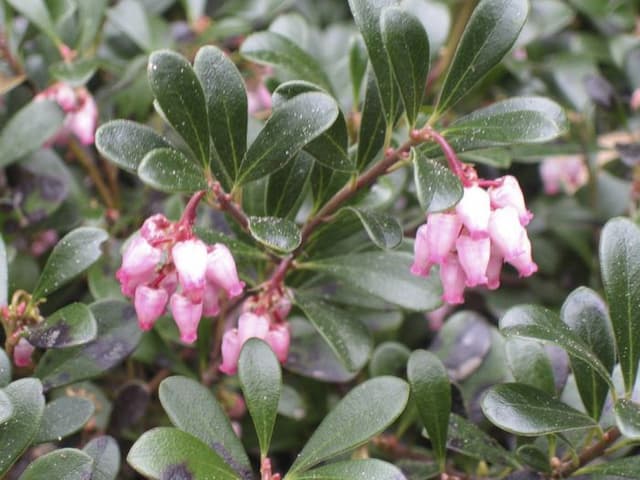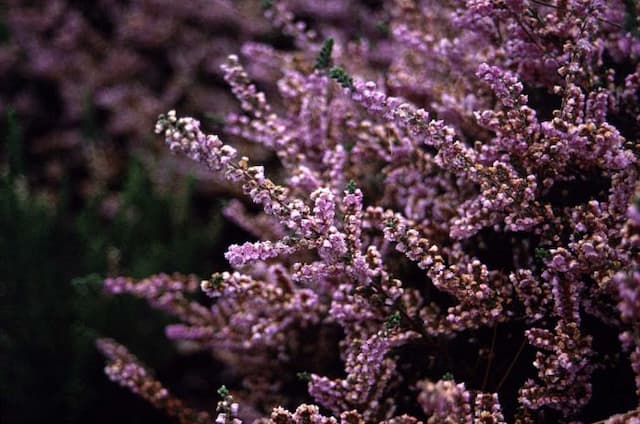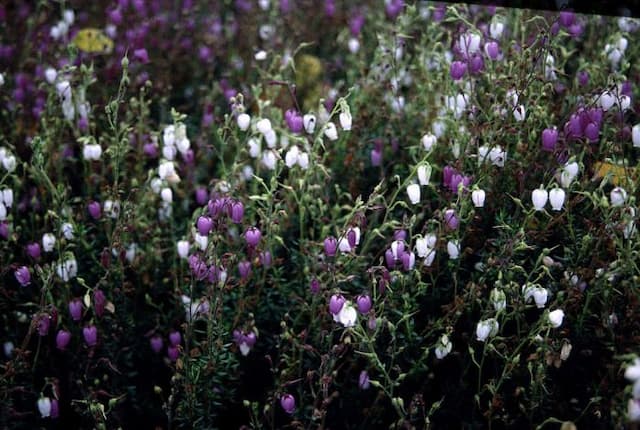Cape Heath Erica canaliculata











ABOUT
Erica canaliculata, commonly known as the Channelled Heath, is a flowering shrub with a pronounced upright growth habit. Its appearance is characterized by thin, needle-like leaves that densely cover the slender, arching stems, contributing to a fine-textured overall look. The foliage of the plant is typically a deep green, which provides a rich backdrop for the abundant flower display. The flowers are small, urn-shaped, and often clustered tightly together along the stems. They are usually a vibrant shade of pink but can also be found in hues that may range from white to deep rose, adding a splash of color to the plant's green canvas. These flowers have a distinctive shape, with four small petals that give them a delicate appearance. They are prominent against the foliage and tend to bloom in profusion, creating an eye-catching display that can be quite showy when the plant is in full bloom. The overall aesthetic of the Channelled Heath is one of natural grace and fine detail. The contrast between the soft flowers and the sharp leaves creates visual interest, making this shrub an attractive choice for gardeners seeking to add texture and color to their plantings. Its appealing look is further enhanced when the flowers are visited by pollinators, such as bees and butterflies, which are often attracted to the blooms for their nectar.
About this plant
 Names
NamesFamily
Ericaceae
Synonyms
Channel-Leaved Heath, Christmas Heather
Common names
Erica canaliculata.
 Toxicity
ToxicityTo humans
Erica canaliculata, more commonly known as the Channel-leaf Heath, is not widely recognized for its toxicity to humans. However, as with many plants, there may be individuals with specific allergies or sensitivities to this plant. Ingesting any part of the plant might result in gastrointestinal discomfort, such as nausea, vomiting, or diarrhea in susceptible individuals due to the inherent chemical compounds. The severity of these symptoms can vary depending on the amount ingested and the sensitivity of the individual. It is generally advisable to avoid ingesting ornamental plants and to seek medical attention if ingestion occurs and symptoms develop.
To pets
The Channel-leaf Heath (Erica canaliculata) is not considered highly toxic to pets, but it can still cause mild gastrointestinal upset if ingested. As with humans, pets might experience symptoms such as vomiting or diarrhea if they consume parts of this plant. While the consequences are usually not severe, pet owners should take caution and prevent pets from eating ornamental plants. If a pet appears to be ill after consuming any part of Channel-leaf Heath or showing any signs of distress, it is important to consult a veterinarian.
 Characteristics
CharacteristicsLife cycle
Perennials
Foliage type
Evergreen
Color of leaves
Green
Flower color
Pink
Height
3 feet (0.9 meters)
Spread
2 feet (0.6 meters)
Plant type
Shrub
Hardiness zones
9
Native area
South Africa
Benefits
 General Benefits
General Benefits- Landscape Aesthetics: Erica canaliculata, commonly known as Christmas heath, is prized for its ornamental value in gardens and landscapes with its slender foliage and colorful blossoms.
- Wildlife Attraction: The plant's flowers are appealing to bees, butterflies, and other pollinators, thereby supporting biodiversity.
- Erosion Control: Christmas heath's root system helps to stabilize soil, making it useful for controlling erosion on slopes and banks.
- Drought Resistance: It is proficient in surviving dryer conditions once established, making it suitable for water-wise gardens.
- Low Maintenance: The plant is considered low-maintenance, requiring minimal care and infrequent pruning to thrive.
- Seasonal Interest: Offering a splash of color with its winter blooms, it adds visual interest to gardens during a time when few other plants flower.
- Versatility: Christmas heath can be used in a variety of garden settings, including borders, containers, and as groundcover or part of rockeries.
 Medical Properties
Medical PropertiesThis plant is not used for medical purposes.
 Air-purifying Qualities
Air-purifying QualitiesThis plant is not specifically known for air purifying qualities.
 Other Uses
Other Uses- Erica canaliculata, commonly known as Channelled Heath, can be used to create a low, dense hedge in gardens, providing structure and year-round interest with its foliage and flowers.
- The wood of Channelled Heath is suitable for crafting small hand-carved objects owing to its density and fine grain once dried and treated.
- Dried branches of the Channelled Heath can be incorporated into floral arrangements, contributing a touch of natural elegance and long-lasting structure.
- This plant's natural resistance to wind makes it an ideal choice for coastal gardens where other species might struggle to survive.
- Because of its attractive flowers, Channelled Heath is commonly used in ornamental pot culture to decorate patios, balconies, and outdoor living areas.
- The multitude of flowers produced by the Channelled Heath can serve as a natural food source for bees and other pollinators, promoting biodiversity in garden settings.
- Due to its evergreen nature, it can be used in garden design to provide winter color when other plants may have lost their leaves.
- Channelled Heath's ability to thrive on nutrient-poor soils makes it a suitable plant for restoring or cultivating in otherwise challenging environments.
- The plant can be trained into artistic shapes and is sometimes used in the art of topiary, especially in formal gardens.
- In landscape photography, Channelled Heath's striking appearance can be used to add visual interest and a splash of color in natural scenes.
Interesting Facts
 Feng Shui
Feng ShuiThe plant Erica canaliculata is not used in Feng Shui practice.
 Zodiac Sign Compitability
Zodiac Sign CompitabilityThe Cape heath is not used in astrology practice.
 Plant Symbolism
Plant Symbolism- Heath (Erica canaliculata) - Heath, including the Erica canaliculata, is often associated with solitude and protection. The extensive heathlands where it grows are solitary places, giving rise to symbolism related to seclusion and introspection. Additionally, these plants are tough and resilient, symbolizing one's ability to withstand harsh conditions and protect oneself against adversity.
- Beauty - Heath flowers are admired for their delicate beauty, which, despite their rugged environment, suggests the idea that beauty can flourish in even the most challenging conditions. This lends the plant a symbolic meaning related to the endurance of beauty and the notion of unexpected grace.
- Good Luck - In some cultures, heath, including Erica canaliculata, is considered to symbolize good luck. This likely stems from the plant's ability to survive and even thrive in poor soil, an admirable trait that may be seen as a metaphor for overcoming difficult circumstances.
 Water
WaterThe common name for Erica canaliculata is 'Channelled Heath.' This plant prefers regular moisture, so it's important to provide a consistent amount of water. You should water the Channelled Heath thoroughly, allowing water to penetrate the soil until it's moist but not saturated. Typically, providing between 16 to 32 ounces of water per week is sufficient. However, this can vary with the size of the plant and the climate conditions. During hot and dry periods, increase watering frequency to maintain soil moisture, but in cooler or wetter conditions, reduce the amount to prevent waterlogging. Always check the top inch of soil for dryness before watering to avoid overwatering.
 Light
LightThe Channelled Heath thrives in full sun to partial shade. For optimal growth, place it in a spot where it receives at least four to six hours of direct sunlight each day. Adequate light is essential for the plant to develop its vibrant foliage and flowers. If growing indoors, a south or west-facing window can provide the necessary light exposure for the Channelled Heath.
 Temperature
TemperatureChannelled Heath prefers cool to moderate temperatures, thriving between 60°F and 75°F. The plant is quite hardy and can tolerate temperatures as low as 20°F but should be protected from frost. It's important to avoid exposure to temperatures over 80°F, as this can stress the plant. Ideal growing conditions for Channelled Heath are in regions where temperature extremes are rare.
 Pruning
PruningPruning Channelled Heath is important to maintain its shape and encourage dense growth. Prune the plant immediately after flowering to prevent cutting off next year's blooms. It's recommended to prune once every year or two, depending on the desired size and shape. Removing any dead or diseased branches should be done as soon as they are noticed to maintain plant health. Lightly trimming the plant helps to stimulate new growth and enhance the appearance of the heath.
 Cleaning
CleaningAs needed
 Soil
SoilCape heath requires well-draining acidic soil with a pH range of 4.5-5.5; a mix comprising peat, sand, and loamy soil in equal parts is ideal for this plant.
 Repotting
RepottingCape heath should be repotted every 2-3 years or when the plant outgrows its current pot to ensure continued health and growth.
 Humidity & Misting
Humidity & MistingCape heath thrives best in moderate to high humidity levels; maintaining humidity around 50-60% is beneficial for this plant.
 Suitable locations
Suitable locationsIndoor
Place Cape heath in bright, indirect light and ensure high humidity.
Outdoor
Plant Cape heath in partial shade with protection from harsh sun.
Hardiness zone
7-9 USDA
 Life cycle
Life cycleErica canaliculata, commonly known as the Canal Cape Heath, begins its life as a seed, often after fire has stimulated flowering and seed set in the adult plants. Upon germination, the seedling grows, establishing a root system and a rosette of leaves, before developing into a juvenile plant. In the juvenile stage, the plant continues to expand in size and begins to form its characteristic needle-like foliage. After reaching maturity, which can take several years, Erica canaliculata produces numerous small, tubular flowers, typically pink to white in color. Successful pollination of these flowers, often by insects, leads to the production of seed capsules containing numerous tiny seeds. The mature plant may continue to flower and set seed for many years, with its lifecycle repeating after each successful generation, and it may also resprout from the base following damage, such as after fire events.
 Propogation
PropogationPropogation time
Spring to early summer
Propogation: Erica canaliculata, commonly known as channelled heath, is most popularly propagated through semi-hardwood cuttings. This method is typically carried out in late summer, after new growth has partially matured. For optimal results, cuttings should be about 2 to 4 inches (5 to 10 centimeters) long and include several leaf nodes. The bottom leaves are removed, and the cut end of the cutting can be dipped in a rooting hormone to encourage root development. Then, the prepared cutting is placed in a well-draining potting mix, kept moist, and covered with a plastic bag or placed in a propagator to maintain high humidity. Roots generally develop within a few weeks to a few months, after which the cutting can be potted up individually.









